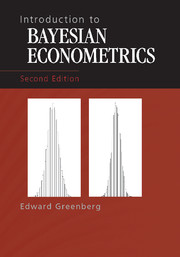Refine search
Actions for selected content:
2584 results in Computational Science
PART TWO - Regression Models
-
- Book:
- Econometric Modelling with Time Series
- Published online:
- 05 January 2013
- Print publication:
- 28 December 2012, pp 155-156
-
- Chapter
- Export citation
Preface
-
- Book:
- Econometric Modelling with Time Series
- Published online:
- 05 January 2013
- Print publication:
- 28 December 2012, pp xxxi-xxxvi
-
- Chapter
- Export citation
PART FIVE - Nonstationary Time Series
-
- Book:
- Econometric Modelling with Time Series
- Published online:
- 05 January 2013
- Print publication:
- 28 December 2012, pp 581-582
-
- Chapter
- Export citation
14 - Structural Vector Autoregressions
- from PART FOUR - Stationary Time Series
-
- Book:
- Econometric Modelling with Time Series
- Published online:
- 05 January 2013
- Print publication:
- 28 December 2012, pp 512-543
-
- Chapter
- Export citation
19 - Nonlinearities in Mean
- from PART SIX - Nonlinear Time Series
-
- Book:
- Econometric Modelling with Time Series
- Published online:
- 05 January 2013
- Print publication:
- 28 December 2012, pp 715-757
-
- Chapter
- Export citation
15 - Latent Factor Models
- from PART FOUR - Stationary Time Series
-
- Book:
- Econometric Modelling with Time Series
- Published online:
- 05 January 2013
- Print publication:
- 28 December 2012, pp 544-580
-
- Chapter
- Export citation

Introduction to Bayesian Econometrics
-
- Published online:
- 05 December 2012
- Print publication:
- 12 November 2012
-
- Textbook
- Export citation
Ternary quadratic forms and half-integral weight modular forms
- Part of
-
- Journal:
- LMS Journal of Computation and Mathematics / Volume 15 / May 2012
- Published online by Cambridge University Press:
- 01 December 2012, pp. 418-435
-
- Article
-
- You have access
- Export citation
Matching simple modules of condensation algebras
- Part of
-
- Journal:
- LMS Journal of Computation and Mathematics / Volume 15 / May 2012
- Published online by Cambridge University Press:
- 01 December 2012, pp. 374-384
-
- Article
-
- You have access
- Export citation
Differential equations and expansions for quaternionic modular forms in the discriminant 6 case
- Part of
-
- Journal:
- LMS Journal of Computation and Mathematics / Volume 15 / May 2012
- Published online by Cambridge University Press:
- 01 December 2012, pp. 385-399
-
- Article
-
- You have access
- Export citation
Examples of linear multi-box splines
- Part of
-
- Journal:
- LMS Journal of Computation and Mathematics / Volume 15 / May 2012
- Published online by Cambridge University Press:
- 01 December 2012, pp. 444-462
-
- Article
-
- You have access
- Export citation
Minimal models for rational functions in a dynamical setting
- Part of
-
- Journal:
- LMS Journal of Computation and Mathematics / Volume 15 / May 2012
- Published online by Cambridge University Press:
- 01 December 2012, pp. 400-417
-
- Article
-
- You have access
- Export citation
Algorithmic construction of Chevalley bases
- Part of
-
- Journal:
- LMS Journal of Computation and Mathematics / Volume 15 / May 2012
- Published online by Cambridge University Press:
- 01 December 2012, pp. 436-443
-
- Article
-
- You have access
- Export citation
10 - Multivariate Responses
- from Part III - Applications
-
- Book:
- Introduction to Bayesian Econometrics
- Published online:
- 05 December 2012
- Print publication:
- 12 November 2012, pp 169-186
-
- Chapter
- Export citation
9 - Semiparametric Regression
- from Part III - Applications
-
- Book:
- Introduction to Bayesian Econometrics
- Published online:
- 05 December 2012
- Print publication:
- 12 November 2012, pp 148-168
-
- Chapter
- Export citation
6 - Basics of Markov Chains
- from Part II - Simulation
-
- Book:
- Introduction to Bayesian Econometrics
- Published online:
- 05 December 2012
- Print publication:
- 12 November 2012, pp 79-92
-
- Chapter
- Export citation
Part III - Applications
-
- Book:
- Introduction to Bayesian Econometrics
- Published online:
- 05 December 2012
- Print publication:
- 12 November 2012, pp 113-114
-
- Chapter
- Export citation
A - Probability Distributions and Matrix Theorems
-
- Book:
- Introduction to Bayesian Econometrics
- Published online:
- 05 December 2012
- Print publication:
- 12 November 2012, pp 223-233
-
- Chapter
- Export citation
8 - Linear Regression and Extensions
- from Part III - Applications
-
- Book:
- Introduction to Bayesian Econometrics
- Published online:
- 05 December 2012
- Print publication:
- 12 November 2012, pp 115-147
-
- Chapter
- Export citation
Contents
-
- Book:
- Introduction to Bayesian Econometrics
- Published online:
- 05 December 2012
- Print publication:
- 12 November 2012, pp v-x
-
- Chapter
- Export citation
